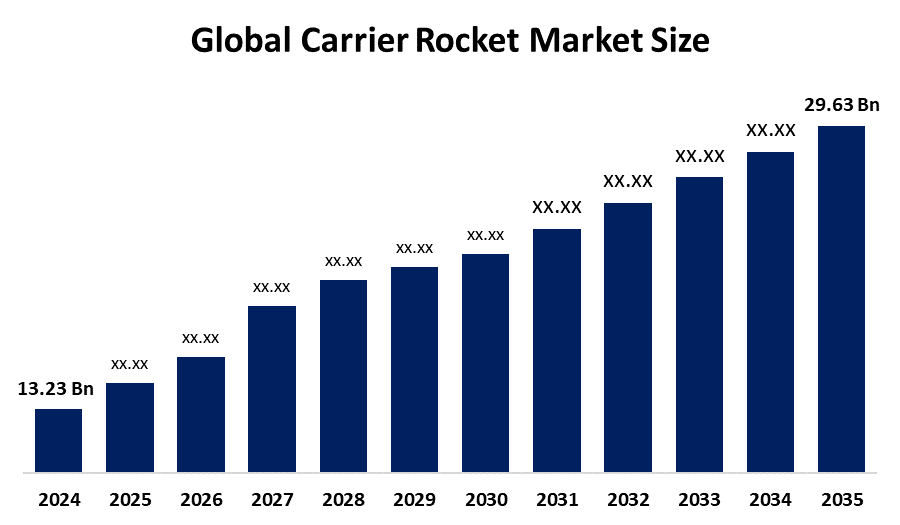
Top 10 Carrier Rocket Market Leaders Worldwide 2025: Strategic Insights & Market Trends
RELEASE DATE: Oct 2025 Author: Spherical InsightsRequest Free Sample Speak to Analyst
Description
According to a Research report published by Spherical Insights & Consulting, the Global Carrier Rocket Market Size is projected to Grow from USD 13.23 Billion in 2024 to USD 29.63 Billion by 2035, at a CAGR of 7.61% during the forecast period 2025–2035. Investments in launch infrastructure across emerging markets are boosting global accessibility and democratizing space exploration. This strong growth in the carrier rocket market is expected to be driven by the growing demand for internet connectivity and IoT services delivered through satellite constellations. In addition to pursuing increasing demand in both government space missions and commercial businesses boost the market growth. The carrier rocket market size is also supported by technological advancements and changing policies in space.
Introduction
A carrier rocket is a particular kind of rocket made to send a payload—like a satellite or spacecraft—into a predetermined orbit or trajectory. These rockets are frequently used to transport cargo for resupply missions because they are usually lightweight and powerful launch vehicles. Furthermore, the market is strengthened by the broad range of applications for carrier rockets in fields like scientific research, communications, and earth observation. They support consistent market growth and the expansion of service offerings for a range of end users. Industry diversification enables the carrier rocket market to withstand changes in demand for specific industry segments. The industry is also focusing on access to smaller, dedicated launches for LEO satellites. Numerous significant players are influencing this market through robust research and development, strategic partnerships, and the continuous improvement of carrier rocket efficiency and design. The increasing demand for satellite launches for telecommunications, scientific research, and earth observation has led to a sharp rise in investment in this sector.
Navigate Future Markets with Confidence: Insights from Spherical Insights LLP
The insights presented in this blog are derived from comprehensive market research conducted by Spherical Insights LLP, a trusted advisory partner to leading global enterprises. Backed by in-depth data analysis, expert forecasting, and industry-specific intelligence, our reports empower decision-makers to identify strategic growth opportunities in fast-evolving sectors. Clients seeking detailed market segmentation, competitive landscapes, regional outlooks, and future investment trends will find immense value in the full report. By leveraging our research, businesses can make informed decisions, gain a competitive edge, and stay ahead in the transition toward sustainable and profitable solutions.
Unlock exclusive market insights - Download the Brochure now and dive deeper into the future of the Carrier Rocket Market.
Carrier Rocket Market Size & Statistics
- The Market Size for Carrier Rocket Was Estimated to be worth USD 13.23 Billion in 2024.
- The Market is Going to Expand at a CAGR of 7.61% between 2025 and 2035.
- The Global Carrier Rocket Market Size is anticipated to reach USD 29.63 Billion by 2035.
- Asia Pacific is expected to generate the highest demand during the forecast period in the carrier rocket market.
- North America is estimated to grow the fastest during the forecast period in the carrier rocket market.

Regional growth and demand
North America is anticipated to grow at the fastest CAGR during the forecast period in the carrier rocket market. Government and private sector investment in space programs, rising demand for commercial and defence satellite launches, and the quick development of reusable launch technologies are some of the major factors influencing the North American carrier rocket market. By using reusable vehicles, leading private companies like SpaceX and Blue Origin spur innovation and reduce launch costs, increasing the frequency and affordability of space missions. Further encouraging technological advancements are favourable regulatory environments, contracts with the public sector, and competitive pressures to improve payload capacity and dependability.
Asia Pacific is projected to generate the highest demand during the forecast period in the carrier rocket market. Significant government expenditures in space programs, the sharp rise in demand for regional satellites, and continuous technological advancements by major players like China, India, Japan, and South Korea all have an impact on the Asia Pacific carrier rocket market. Alongside the growth of private sector participation, the market is driven by state-backed initiatives and national ambitions, such as China's massive satellite constellations and India's cost-effective launch solutions. The need for smaller satellites is growing, regional R&D spending is increasing, and national agencies and private companies are working together to promote innovation, reusable launch technologies, and operational efficiency.
Top 10 trends in the Carrier Rocket Market
- Reusable Rocket Technologies
- Miniaturisation of Satellites
- Rideshare and Dedicated Launch Models
- Commercialisation of Space Access
- Government-Backed Space Programs
- Cryogenic and Hybrid Propulsion Advances
- Asia-Pacific Launch Expansion
- Environmental Sustainability Push
- Satellite Constellation Deployments
- AI and Automation in Launch Systems
1. Reusable Rocket Technologies
Reusable launch systems, which drastically lower per-launch costs, are being used by businesses like SpaceX and Blue Origin to increase cost-efficiency.
2. Miniaturisation of Satellites
The need for lighter, more manoeuvrable carrier rockets designed for low Earth orbit (LEO) missions is being driven by the increase in small satellite (smallsat) deployments.
3. Rideshare and Dedicated Launch Models
Market accessibility is being increased by flexible launch options, such as dedicated launches for larger or more sensitive payloads and rideshare missions for smaller payloads.
4. Commercialisation of Space Access
The private sector is becoming more involved, with both established aerospace companies and startups providing launch services for Internet of Things, telecom, and Earth observation applications.
5. Government-Backed Space Programs
The need for domestic carrier rocket development is being increased by national investments in space exploration, such as China's lunar missions and India's Gaganyaan.
Empower your strategic planning:
Stay informed with the latest industry insights and market trends to identify new opportunities and drive growth in the carrier rocket market. To explore more in-depth trends, insights, and forecasts, please refer to our detailed report.
Top 10 Companies Leading the Carrier Rocket Market
- SpaceX
- Blue Origin
- United Launch Alliance (ULA)
- Northrop Grumman
- Arianespace
- Lockheed Martin
- Rocket Lab
- China National Space Administration (CNSA)
- Roscosmos
- ISRO (Indian Space Research Organisation)
1. SpaceX
Headquarters: Texas, USA
With its emphasis on reusable rocket technology and affordable launch options, SpaceX, a well-known American aerospace manufacturer and provider of space transport services, has completely transformed the carrier rocket market. Additionally, the company is working on the Starship system, which is intended for interplanetary travel and heavy payload capacity. Its dependability, quick launch cadence, and growing constellation deployments like Starlink, SpaceX promoted the commercial satellite launch market with a significant portion of worldwide payload deliveries. Its creative strategy has sped up the expansion of the orbital launch sector and established new benchmarks for market scalability and efficiency for carrier rockets.
2. Blue Origin
Headquarters: Washington, USA
The New Glenn carrier rocket, a heavy-lift, partially reusable launch vehicle intended for orbital missions, was developed by Blue Origin, a well-known American aerospace manufacturer and spaceflight services provider. For instance, the New Glenn rocket has a two-stage design: an expendable second stage that runs on liquid hydrogen and oxygen, and a reusable first stage that can support at least 25 re-flights thanks to its seven BE-4 methane/oxygen engines. Blue Origin is a formidable competitor in the carrier rocket market thanks to its emphasis on reusability and cutting-edge engine technology, which spurs innovation and increases the range of launch service options available from its Cape Canaveral location.
3. Northrop Grumman
Headquarters: Falls Church, USA
Low Earth orbit (LEO) supply missions to the International Space Station and small to medium satellite deployments are among the company's dependable and adaptable launch solutions. In order to increase payload capacity and cost effectiveness, Northrop Grumman and Firefly Aerospace are also working together to develop the next-generation Eclipse launch vehicle. Their rockets meet the needs of commercial, civil, and national security space by utilising cutting-edge propulsion systems, avionics, and mission integration expertise. Further demonstrating its important role in the space exploration and defence industries, Northrop is actively involved in supplying solid rocket boosters for NASA's Space Launch System.
4. Arianespace
Headquarters: Évry-Courcouronnes, France
Arianespace, which specialises in carrier rocket launches, is the operator of important European launch vehicles, including the medium-to-heavy lift rocket Ariane 6 and the small payload Vega C. Offering customised solutions for launching satellites into a variety of orbits for commercial, institutional, and scientific clients, the company mainly coordinates launch. Having launched more than 1,100 satellites for more than 150 clients in 50 countries over the course of its more than 40 years in business, Arianespace has proven its dependability and proficiency in dual and multiple payload launches.
5. Lockheed Martin
Headquarters: Maryland, USA
Lockheed Martin Corporation is a well-known American aerospace and defence business that plays a significant role in the global market for carrier rockets. The company's innovations are concentrated on next-generation space defence systems, strategic missile systems like the Trident II, precision payload delivery, and reusable technologies. Lockheed Martin supports government, defence, and private space operations throughout North America and beyond by utilising its extensive knowledge of propulsion, aerospace engineering, and AI integration.
Are you ready to discover more about the carrier rocket market?
The report provides an in-depth analysis of the leading companies operating in the global carrier rocket market. It includes a comparative assessment based on their product portfolios, business overviews, geographical footprint, strategic initiatives, market segment share, and SWOT analysis. Each company is profiled using a standardized format that includes:
Company Profiles
- SpaceX
- Business Overview
- Company Snapshot
- Products Overview
- Company Market Share Analysis
- Company Coverage Portfolio
- Financial Analysis
- Recent Developments
- Merger and Acquisitions
- SWOT Analysis
- Blue Origin
- United Launch Alliance (ULA)
- Northrop Grumman
- Arianespace
- Lockheed Martin
- Rocket Lab
- China National Space Administration (CNSA)
- Roscosmos
- ISRO (Indian Space Research Organisation)
- Others.
Conclusion
The worldwide carrier rocket market is set for significant growth, with its value expected to increase from USD 13.23 billion in 2024 to USD 29.63 billion by 2035, reaching a strong CAGR of 7.61%. This swift expansion is mainly driven by the fast-tracking of extensive satellite constellations for internet and IoT services, along with marked rises in both commercial and governmental space endeavours. The market is fundamentally transforming due to the embrace of reusable rocket technologies (SpaceX, Blue Origin) and the increasing need for rideshare and dedicated launch options spurred by satellite miniaturisation. Though the Asia-Pacific region is anticipated to create the greatest total demand owing to significant government-supported initiatives (China, India), North America is expected to expand the most rapidly, driven by intense private sector innovation and rivalry. The competitive arena is led by major companies such as SpaceX, Blue Origin, ULA, and Arianespace, each emphasising enhancements in launch cost-effectiveness, payload capability, and mission dependability to address the rising worldwide demand for space access
Browse Related Reports
Global Aerospace Nanotechnology Market Size to Exceed USD 7.54 Billion by 2033
Global Free Space Optics Communication Market Size to Exceed USD 21.11 Billion by 2033
Global Cerium Oxide Nanoparticles Market Size to worth USD 1663.8 Million by 2033
Global Betavoltaic Device Market Size to worth USD 547.5 Million by 2033
Global Reduced Fat Butter Market Size Insights Forecasts to 2035
About the Spherical Insights & Consulting
Spherical Insights & Consulting is a market research and consulting firm which provides actionable market research study, quantitative forecasting and trends analysis provides forward-looking insight especially designed for decision makers and aids ROI.
Which is catering to different industry such as financial sectors, industrial sectors, government organizations, universities, non-profits and corporations. The company's mission is to work with businesses to achieve business objectives and maintain strategic improvements.
CONTACT US:
For More Information on Your Target Market, Please Contact Us Below:
Phone: +1 303 800 4326 (the U.S.)
Phone: +91 90289 24100 (APAC)
Email: inquiry@sphericalinsights.com, sales@sphericalinsights.com
Contact Us: https://www.sphericalinsights.com/contact-us
Need help to buy this report?